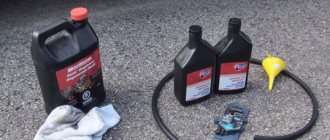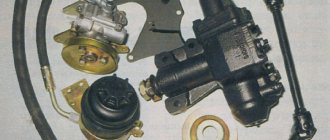Why and when you need to change the oil in the hydraulic booster, signs of fluid wear, which results from untimely replacement of the lubricant. Video about changing power steering oil.
Today, almost every car has a power steering column. Automakers use two power steering technologies - hydraulic power steering (power steering) and electric power steering (EPS). Since the second type appeared relatively recently, most models use a hydraulic system.
Is there life without power steering?
Hydraulic power steering is responsible not only for comfort, but also increases driving safety. With power steering, the steering wheel turns much easier, and a slight hand movement is enough to turn, which significantly improves the driver’s maneuverability and responsiveness. In addition to convenience, the hydraulic booster smoothes out vibrations and shocks from road unevenness, and also provides additional insurance in the event of force majeure in the event of an unexpected tire puncture, allowing you to hold the steering wheel and level the trajectory.
In addition to all the advantages, power steering has another undeniable advantage - it is simple and unpretentious to maintain. It is enough to periodically check the serviceability of the elements and update the special hydraulic fluid.
Difficulties
The main “killer” of power steering is a torn boot. Moisture begins to penetrate into the damaged area and settles on the shafts. This leads to the formation of rust on them. Such a shaft wears down the protective sleeve and oil seals of the hydraulic cylinder, which causes fluid to begin to flow out and a backlash in the shaft to form.
Some drivers pour brake fluid into the hydraulic booster, which is a mistake, as it corrodes seals and tubes. It is prohibited to fill the power steering with any compound other than PSF or ATF. Also, do not mix two different liquids - this can cause density differences, which will increase the load on the pump.
Why change the power steering fluid?
Properly selected power steering fluid plays a critical role: it is the one that powers the entire system and transfers pressure from the pump to the piston. In addition, the liquid performs lubricating, cooling and anti-corrosion functions thanks to the additives contained in the composition. Without it, full operation of the mechanism is impossible: insufficient fluid level in the tank or its poor quality inevitably lead to breakdowns of individual power steering elements and steering problems (most often the rack and gearbox), which can lead to loss of control over the car.
Also, do not forget about the accelerated wear of units - without the necessary lubrication, the service life of the power steering system is sharply reduced, and the risk of premature repair is added to the loss of safety. Do you need it?
Fluid replacement intervals
Having a car is not enough just to be able to drive it. It is necessary to know the replacement intervals for technical fluids. The trouble-free operation of all systems depends on this. Fresh fluid extends the life of the parts it comes into contact with.
Periodically, your car has to change the lubricant in the engine, gearbox, coolant and brake fluid.
Rules for replacing technical fluids
Each type of liquid has its own service life. Manufacturers have established certain intervals for their replacement.
The replacement procedure is not particularly difficult. Each driver can do this himself. The main thing is to know when and why to change fluids.
There are situations when the fluid needs to be replaced ahead of schedule. This can happen with engine oil, coolant or brake fluid.
Before replacing, you must purchase fresh fluid. In this case, you should know how much volume is needed. The choice should be made in accordance with the car manufacturer's recommendations.
If you do the replacement yourself, you need to prepare a container in advance where the old liquid will be drained. For work, you need to use special protective gloves to prevent liquid from getting on the skin of your hands.
All used fuel and lubricants products must be disposed of appropriately.
Power steering fluid change interval
Power steering ensures smooth and comfortable driving. For power steering to function, a sufficient volume of fluid in the system is necessary. To control its level in the engine compartment, there is a special tank with the corresponding MAX and MIN marks, or, if there are no inscriptions on the tank, then the tank cap performs the function of a measuring probe.
The normal power steering fluid level may vary depending on the specific vehicle model. During normal operation of the power steering system, there is no need to frequently add fluid, but in the event of a leak and depressurization, the fluid level may drop to a critically low level. The main signal that something is wrong with the steering system is a suddenly “heavier” steering wheel. In this case, it is necessary to check the fluid level and contact a service station to diagnose the operation of the entire steering system.
Many manufacturers claim that power steering fluid does not require replacement during the entire life of the vehicle. However, this statement is wrong. Power steering fluid, like any other technical fluid, has its own service life. Therefore, it is recommended to change the power steering fluid 1-2 times a year, depending on operating conditions. The maximum recommended interval for replacing power steering fluid is every 80 - 100 thousand km. mileage
Brake fluid change interval
A properly functioning braking system is the key to the safety of the driver and his passengers. It is necessary to monitor its serviceability regularly. For operation, brake fluid is poured into the system. Depending on the manufacturer, it may differ in composition and name. When choosing a fluid for your car, you should strictly adhere to the manufacturer’s recommendations. This applies not only to the brand, but also to the brake fluid replacement interval.
To control the brake fluid level, there is a reservoir with two marks: for minimum and maximum volume.
During normal operation of the brake system, topping up is not required. At the same time, it must be taken into account that brake fluid is hygroscopic. Over the course of a year, it can absorb 2-3% of water from the air. In this regard, corrosion will begin to appear on the inner walls of the parts over time, and the liquid itself will lose its properties. As a result, this can affect the operation of the entire braking system: braking efficiency will decrease, and the braking distance, on the contrary, will increase.
Sometimes it is not known when the brake fluid was last changed. This often happens when buying a used car. In this case, you can contact a service station, where they will check its quality using a special device and, if necessary, carry out a replacement procedure. In normal condition, brake fluid has a clear golden color.
The recommended frequency for replacing brake fluid is every 1-2 years, regardless of mileage, or after a mileage of 60,000 km (whichever comes first). You should not change the brake fluid more often, as this will not have any effect.
Coolant (antifreeze) replacement interval
Antifreeze or antifreeze is used as a coolant in cars. Less common is ordinary water, as it promotes corrosion.
The frequency of replacing the coolant may depend on the operating conditions of the vehicle. Monitoring the engine cooling fluid level is not difficult. To do this, there is an expansion tank in the engine compartment with two marks: minimum and maximum. The exact level can be monitored on a cold engine. If necessary, add coolant to the expansion tank. This has to be done more often than with other technical fluids, since the degree of evaporation of the coolant is very high.
If it is necessary to replace the antifreeze in a car, then this should be done only when the engine has cooled down sufficiently. It is strictly forbidden to open the radiator cap while it is hot.
It is not recommended to mix different types of coolants with each other.
If you are replacing the coolant yourself, then you need to choose the right type of fluid: antifreeze or antifreeze, and also check whether it is a concentrate that needs to be diluted with distilled water.
The frequency of replacing antifreeze in a car, as well as antifreeze, is every two to three years or after 60-70 thousand km. vehicle mileage.
Gearbox oil change interval
There are two main types of transmissions: manual and automatic.
The method for checking the oil level in them may differ depending on the design. Sometimes this requires taking the car to a service station. The service life of transmission oil in different cars is from 20 to 60,000 km. The manufacturer often indicates the timing of oil changes on the packaging.
The timing of the transmission oil change may be influenced by the operating conditions of the vehicle. If the gearbox overheats frequently, oxidative processes in the oil begin to activate. In this regard, tar deposits are formed. The lubricant begins to lose its anti-wear and extreme pressure properties.
External factors can also affect the rate of oil wear. If dust or water gets inside the unit, it will lose its lubricating properties.
Gearbox oil can be mineral or synthetic.
A more precise frequency of changing transmission oil depends on the design of the gearbox and the type of oil.
Synthetic oil for automatic transmission / manual transmission
- Under normal operating conditions, 60,000 km or every 2 years.
- Under severe operating conditions, 30,000 km or every year.
Mineral oil for manual transmission
- Normal conditions - 50,000 km / 2 years.
- Severe conditions - 25,000 km / 1 year.
Robotic gearboxes and CVTs deserve special attention. The required oil level in these units is extremely important for their normal operation.
In such boxes it is recommended to change the oil every 25,000 - 30,000 km. Many car owners adhere to this recommendation, regardless of the operating conditions of the car. It is especially important to observe this interval for older cars.
It is advisable to change the oil in the automatic transmission and variator at a service station. If you simply drain the lubricant from the unit, some of it will remain in the torque converter, pump and valve body. When pouring, fresh oil will mix with old oil and lose some of its properties.
Service stations often have special equipment for pumping oil out of the cavities of the unit.
Compliance with replacement intervals for technical fluids is vital for the normal functioning of vehicle components. Neglecting this will inevitably lead to unpleasant consequences.
How do you know when it's time to change the power steering fluid?
Changing the power steering oil is described in detail in the vehicle's operating manual. There you can see everything: from recommended manufacturers and frequency to a step-by-step algorithm of what to fill and where.
In any case, it would be useful to diagnose the quantity and quality of the liquid every six months. The first thing you should pay attention to is the oil level. It should be between the MAX and MIN marks (for a warm and cooled engine - HOT MAX / HOT MIN and COLD MAX / COLD MIN, respectively).
Next, check the quality: take a few drops from the tank and test on a light surface (for example, paper). Compare the color, purity and clarity of the used liquid with new one from the canister. If the color has changed, become cloudy, foreign particles and impurities have appeared, or you feel a specific burning smell, it’s definitely time to change the oil.
Signs of oil wear
There are simple instructions that allow you to determine the unsuitability of power steering oil for further use:
- it is necessary to open the power steering reservoir cover;
- You should check the normal color of the oil at the time of filling - for example, red, green or yellow. If there are leftovers of the original product, you need to pour it into a plastic cup and make a simple comparison;
- if the oil becomes dark, this indicates the need to replace it;
- if the shade is dark brown, this is an alarming sign;
- and if the oil starts to look like hot chocolate, the situation gets worse - it needs to be replaced as soon as possible.
To avoid such developments, you should not only take into account the recommended oil change intervals depending on the mileage, but also check its level during each technical inspection.
What kind of oil should I put in the power steering?
Before you buy power steering fluid, it is important to determine what is actually being poured into the power steering and which fluid is right for you.
Traditionally, car enthusiasts distinguish oil by color: red, yellow and green. However, the main thing remains not the color, but the composition of the substance, indicating its main characteristics: viscosity, hydraulics, chemical properties, versatility.
Based on the type of base, all oils are divided into mineral and synthetic. In most cases, mineral-based fluids are used for the power steering system, since they do not contain aggressive components that can harm rubber elements and lead to failure. However, there are models for which manufacturers specify synthetics.
If you have to change the power steering oil, follow two main rules:
- do not mix green liquids with substances of other colors;
- do not combine mineral and synthetic preparations.
What does a late power steering oil change lead to?
Many domestic motorists remember changing the power steering oil only after it fails. What could this lead to? The waste liquid contains a large number of small contaminants , such as:
- metal shavings;
- the smallest impurities.
The listed components seriously harm the hydraulic system, especially the filter elements located in the power steering reservoir. This part quickly becomes clogged, and the pump is under enormous loads. As a result, it fails, and there is a need for expensive repairs.
Power steering oil is not as hygroscopic as brake oil, but it does absorb condensation. The entry of water into the system provokes rapid and intense corrosion of the steering rack.
Also, condensation in the oil increases its viscosity in winter. The circulation of the substance is suspended, and an additional load is placed on the unit and its sealing components. As a result, the device is subject to depressurization, leaks and hum in the engine compartment. And in hot periods, the oil with condensation becomes excessively liquid (watery). As a result, it ceases to create optimal pressure on the wheel elements, the steering wheel becomes “heavy”, and jerks occur when trying to turn it.
If in winter, after starting the ignition, a hum is heard that gradually disappears, perhaps we are talking about overload on the pumping equipment. As a result, the service life of the system is greatly reduced. Therefore, it is recommended to change the oil before the start of the winter season if the replacement date is close. And if you plan to change the oil at the end of winter, then it is better to postpone the procedure to spring. In this case, you can avoid diluting the oil with condensation and deteriorating the effort during the warm season.
How to change the oil in the power steering?
Replacing power steering fluid is a simple procedure, and you can do it yourself. You will need a syringe with a tube and a container for draining. Unscrew the cap of the power steering reservoir and use a syringe to completely pump out the old fluid, then fill in new fluid to the maximum level. Start the car and turn the steering wheel several times until it stops in each direction. Stop the engine and check the quality of the oil in the reservoir. If the color and degree of transparency are insufficient, repeat the procedure as many times as necessary.
However, keep in mind: if the oil has been used for too long and has lost all its properties, a partial replacement will not be possible - you will have to completely change the fluid.
Flushing the gearbox
When switching to another transmission oil, after purchasing a used car, or when undergoing scheduled repairs, it is recommended to flush the steering gear.
To do this, mix transmission or motor oil with diesel fuel in a 3:1 ratio.
The mixture is poured into the system after removing the old oil, then jack up one wheel, start the engine and leave it running at first speed for a few minutes. After this, the washing is drained.
Which power steering fluid to buy?
When choosing power steering fluid, pay attention to the following characteristics:
- resistance to high temperatures (up to 110ºС);
- the presence of additives that reduce friction and wear;
- the presence of viscosity and acidity stabilizers;
- prevention of foaming;
- anti-corrosion properties;
- safety for the driver (no aggressive chemical components in the composition);
- reliable and recommended manufacturer.
Our choice is KIXX automobile oils from GS Caltex: heat-resistant, environmentally friendly, with universal viscosity characteristics, corrosion inhibitors and antioxidant elements, KIXX oils retain their properties and work effectively in any conditions and temperatures. A wide product range, strict control and the use of the latest technologies have allowed GS Caltex Corporation to be one of the generally recognized world leaders in the production of lubricants for many years.
| Manufacturer | vendor code | Name |
| KIXX | L250944TE1 | Automatic transmission fluid ATF DX-III, synthetic SYNTHETIC (T) KR 4L (old number L522144T) |
In IXORA stores you can always find all the necessary spare parts and accessories. Our qualified managers will help you with your choice!










